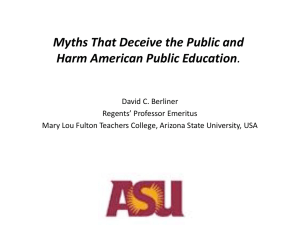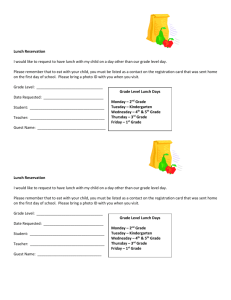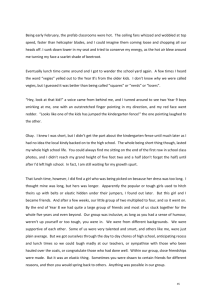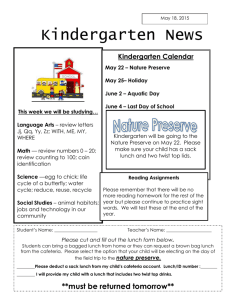GSSA 2015 Fall Bootstrap – Keynote – David Berliner
advertisement
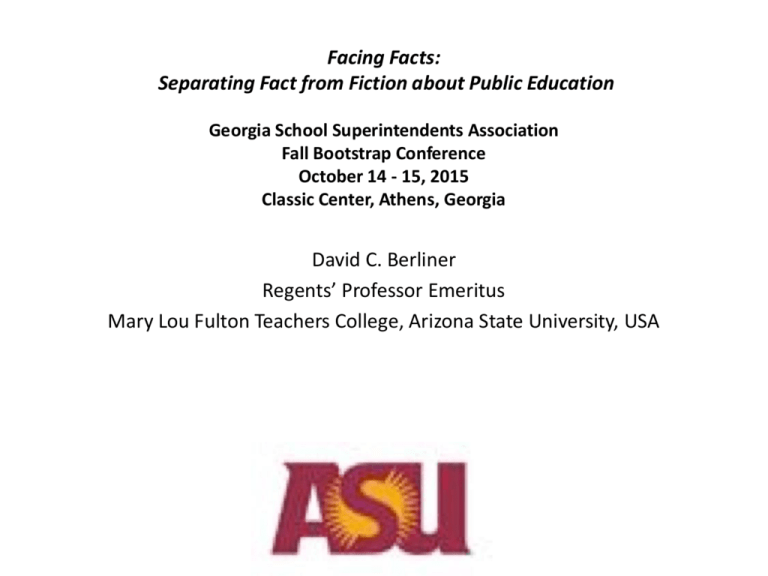
Facing Facts: Separating Fact from Fiction about Public Education Georgia School Superintendents Association Fall Bootstrap Conference October 14 - 15, 2015 Classic Center, Athens, Georgia David C. Berliner Regents’ Professor Emeritus Mary Lou Fulton Teachers College, Arizona State University, USA Ridicule is the only weapon which can be used against unintelligible propositions. - Thomas Jefferson 30 July, 1816 “You are entitled, sir, to your own opinions, but not your own facts” - Senator Daniel Patrick Moynihan, at a Senate hearing. QUOD GRATIS ASSERITUR, GRATIS NEGATUR (That which is alleged without proof may be dismissed without explanation.) “Educational reform is a euphemism for the destruction of public education.” Noam Chomsky Facts do not cease to exist because they are ignored -Aldous Huxley I wonder: Can anyone in our government and among our industrial leaders still add? 442,000 new stem graduates a year, for 277,000 jobs a year equals a surplus of 165,000 STEM grads a year. An obsession with metrics forces us to be less trusting of our observational skills and to put too much faith in metrics that appear to be “objective,” “ hard,” or “quantifiable.” Will County School District 92, , Lockport, IL. continues to improve teaching and learning for all students. We are pleased to announce that District 92 will implement a new standards-based report card for kindergarten students. General English Language Arts Kindergarten Expectations: Follow words left to right, top to bottom, and page by page. Recognize how spoken words are represented in written language. Understand that words are separated by spaces. Recognize and name upper and lower case letters. Recognize and produce rhyming words. Count, pronounce, blend, and segment syllables. Blend and segment onsets and rhyming words. Isolate and pronounce the phonemes in CVC words. Demonstrate knowledge of one-to-one letter-sound correspondence. Associate the long and short sounds with the five major vowels. Distinguish between similarly spelled words by identifying the sounds of the letters that differ. Read grade level high-frequency sight words with automaticity. Read emergent-reader text with purpose and understanding. For Reading Informational Texts: Determine the meaning of unknown words. Determine the meaning of multiple-meaning words and phrases. Uses sight words, letter/sounds, onset/rhymes, and connections to other words. Chunks words. Uses context/pictures. Asks and answers questions about unknown words. Uses multiple sources of information (visual, syntax, meaning). Remembers and uses details when discussing text. Identifies the main idea and retells key details. Make predictions using information from pictures/text features. Make predictions based on information gained through reading. Describes the relationship between illustrations/pictures and the text. Reading Literature: Determine the meaning of unknown words. Determine the meaning of multiple-meaning words and phrases. Uses sight words, letter/sounds, onset/rhymes, and connections to other words. Chunks words. Uses context/pictures. Asks and answers questions about unknown words. Use multiple sources of information (visual, syntax, meaning). Identify parts of a book and parts of a text. Remember and use details when discussing text. Name and understand the role of the author and illustrator of a story. Thinking Beyond the Text: Recognize attributes of recurring characters, Recognize common types of text, Make connections between the illustrations and the text. Compare and contrast characters in familiar stories. Acquire and report new information. Talk about prior knowledge. Infer and talk about characters’ feelings, motives, and attributes. Show evidence to support inferences. Thinking About the Text: Notice how the writer has made the story funny or surprising. Identify and appreciate humor. Understand that a story has a beginning, a series of events, and an end. Discuss how writers use interesting characters. Ask and answer questions about key details. Point out connections between text and pictures. Express opinions about the quality of text . It looks like this for Writing and Mathematics as well……… And In Ohio: Kindergarten students are tested 11.3 hours, on average, and grade 1 students Are tested 11.6 hours, on average. Test preparation time = 26.3 hours and 26. 6 hours respectively. This is more time for testing than used to be Allocated for elementary school instruction in the visual arts before NCLB! kindergarteners Here’s what in Florida are going to be subjected to this year, according to Valerie Strauss of the Washington Post: From August 10-September 30 they will take the Florida Kindergarten Readiness Screener (Work Sampling System and Florida Assessments for Instruction in Reading). From March 2-April 3, they’ll take the Comprehensive English Language Learning Assessment. From April 13-17, they’ll take the Stanford Achievement Test, Tenth Edition for Reading and Mathematics. From April 13-May 29 they’ll take the Florida Assessments for Instruction in Reading Assessment Period 3 (AP3) From May 11-June 5, they will take the District-Designated End-of-Course Assessment And, just in case they haven’t had enough by that point, Florida kindergarteners also have the option of taking these two tests: 1. To see if they are “gifted:” ”The Iowa Tests (Iowa Tests of Basic Skills and Iowa Tests of Educational Development), either the English or English Language Learners (ELL) version. 2. To decide about placement for English to Speakers of Other Languages (ESOL): Miami-Dade County Oral Language Proficiency Scale Revised In 2014 the World Global Entrepreneurship and Development Index (The GEDI) was released. 120 countries were assessed and ranked by researchers associated with the Imperial College Business School, the London School of Economics and Political Science, University of Pécs, and George Mason University. The number 1 country in the world was: Ta Da!..............................................The USA! The authors say: “Entrepreneurship plays a crucial role in the US economy and as result, policy initiatives are created to encourage entrepreneurial behavior. This, coupled with the culture of determination and motivation, makes the US a great place to be an entrepreneur. [Moreover,] the gulf between the United States and other countries is large and appears to be widening,…. not narrowing.” Furthermore, “this year's Index compared the experience of male and female entrepreneurs for the first time, to reflect the increasing participation and importance of women in entrepreneurship around the world. The researchers determined that the US is………….Ta Da! The worlds leader in female entrepreneurship.” Source: http://www.thegedi.org/research/gedi-index/ Number Six Pupils recite Di Zi Gui, which translates as 'standards for being a good student and child', in the playground of Jiale Centre primary school in Hainan province, China. Number of jobs available, 2014, and number unemployed in that sector: Economic Policy Institute. 2012 PISA Results Mean/Average Scores No examination of variation Reading Singapore Japan Korea Finland Canada Ireland Poland Estonia Lichtenstein Australia Etc. US is #21 Mathematics Singapore Korea Japan Lichtenstein Switzerland Netherlands Estonia Finland Canada Poland Etc. US is # 32 Science Singapore Japan Finland Estonia Korea Vietnam Poland Canada Lichtenstein Germany Etc. US is #23 15 year-old students in public schools with half or more of students eligible for free or reduced-price lunch had lower average MATHEMATICS literacy scores than both the U.S. and OECD averages—These are the bottom 2 bars. But look again at the top two bars and even the third bar. Same trend as in 2009 Less than 10 percent 540 (*,**) 10 to 24.9 percent 513 (*,**) 25 to 49.9 percent 506 (*) OECD OECDaverage average 494 (*) U.S. U.S.average average 481 (**) 50 to 74.9 percent 464 (*,**) 75 percent or more 432 (*,**) 0 100 200 300 Score 400 500 1000 600 700 * Significantly different from U.S. average **Significantly different from OECD average Note: The National School Lunch Program provides free or reduced-price lunch for students meeting certain income guidelines. The percentage of students receiving such lunch is an indicator of the socioeconomic level of families served by the school. Estimates of the percentage of students eligible for free or reduced-price lunch are based on principals’ reports. 27 15-year-old students in public schools in which half or more of students were eligible for free or reduced-price lunch had lower average SCIENCE literacy scores than both U.S. and OECD averages Less than 10 percent 556 (*,**) 10 to 24.9 percent 528 (*,**) 25 to 49.9 percent 523 (*,**) OECD OECDaverage average 501 U.S. U.S.average average 497 50 to 74.9 percent 483 (*,**) 75 percent or more 442 (*,**) 0 100 200 300 400 500 600 700 1000 Score * Significantly different from U.S. average **Significantly different from OECD average Note: The National School Lunch Program provides free or reduced-price lunch for students meeting certain income guidelines. The percentage of students receiving such lunch is an indicator of the socioeconomic level of families served by the school. Estimates of the percentage of students eligible for free or reduced-price lunch are based on principals’ reports. 28 Students in public schools in which half or more of students were eligible for free or reduced-price lunch had lower average READING LITERACY scores than both the U.S. and OECD averages Less than 10 percent 559 (*,**) 10 to 24.9 percent 524 (*,**) 25 to 49.9 percent 519 (*,**) U.S.average average U.S. 498 OECDaverage average OECD 496 50 to 74.9 percent 479 (*,**) 75 percent or more 452 (*,**) 0 100 200 300 400 500 600 700 1000 Score * Significantly different from U.S. average **Significantly different from OECD average Note: The National School Lunch Program provides free or reduced-price lunch for students meeting certain income guidelines. The percentage of students receiving such lunch is an indicator of the socioeconomic level of families served by the school. Estimates of the percentage of students eligible for free or reduced-price lunch are based on principals’ reports. 29 TIMSS 4TH GRADE SCORES BY SCHOOL POVERTY LEVEL: MATH TIMSS 8TH GRADE SCORES BY SCHOOL POVERTY LEVEL: MATH PIRLS READING AT 4TH GRADE: USA DID FINE OVERALL BUT SAME PATTERN Four of the best high schools in the USA, according to US News and World Report Four of the best high schools in the USA, according to US News and World Report Four of the best high schools in the USA according to US News and World Report Looks a lot like skimming and creaming going on to me!!!!! These schools simply will not take all who apply or they kick out those that they don’t want to educate or are unable to educate. Basis schoolScottsdale: 146 to 21 Great HeartsChandler: 113 to 45 Teachers account for about 10% Schools account for about 10% Out of school factors account for about 60% Vs. OUTSIDE-OF-SCHOOL FACTORS AFFECTING WHAT OCCURS INSIDE-THESCHOOL AND INSIDE-THE-CLASSROOM. Percent of low birth-weight children in the neighborhood. Inadequate medical, dental and vision care in family and neighborhood. Food insecurity in family. Environmental pollutants in home and neighborhood. Family relations and family stress. Percent of mothers at the school site that are single and/or teens. Percent of mothers at the school site that do not possess a high school degree. Language spoken at home. Family income. Neighborhood characteristics [including sense of collective efficacy] Rate of violence in the neighborhood. Drug use in the neighborhood. Mental health in the neighborhood. Average income in neighborhood. Mobility rates of families in the neighborhood. Availability of positive Role models in the community. Availability of high quality early education. Transportation to get to jobs. Etc. INSIDE THE SCHOOL FACTORS AFFECTING WHAT OCCURS INSIDE THE CLASSROOM Class size. Quality of the principal and other administrators. Collective efficacy of the faculty. Teacher turnover or school churn rates. Quality of the school facilities. Quality and Frequency of Professional Development Opportunities. Curriculum. Availability of counseling and special education services. Availability of librarians and school nurses. Integration of music, art, and sports programs. Provision of after school programs. School finances from state and district funds. School funding from parents and community. Parent involvement. U.S. Asian and White students had higher average scores than both the U.S. and OECD averages in mathematics literacy Asian 549 (*,**) White 506 (*,**) OECD OECDaverage average 494 (*) Multiracial 492 U.S. U.S.average average 481 (**) Hispanic 455 (*,**) Black 421 (*,**) 0 100 200 300 400 500 600 1000 700 Score * Significantly different from U.S. average **Significantly different from OECD average 51 Relationship between a nations inequality in income (Gini Coefficient, high being more unequal) and Average PISA (2006) mathematics score just among the wealthy nations (Condron, 2011). Relationships for science and reading scores are similar. 59
